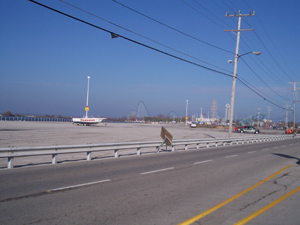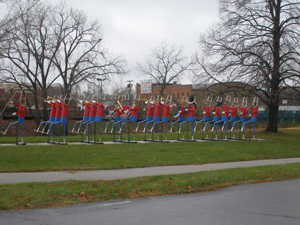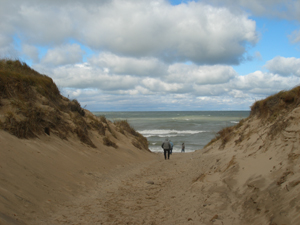Most of this month we've been in northern Ohio, Indiana, and Illinois. We've
continued to meet Slovak relatives and returned to our inquiries about German ones.
Aside from one snowy day, we've had typical fall weather for this part of the country
-- cool to cold, generally gray, with some rain and some patches of sunshine.
We've watched the countryside transform from Halloween to Thanksgiving to Christmas
-- it's interesting to us, because (as least as far as home decorations are concerned)
it's a non-stop decoration orgy. Ghosts and skeletons and inflatable gravestones give
way seamlessly to cornstalks and scarecrows and gourds; jack-o-lanterns are a bit passe,
but pumpkins and fall foliage decorate the scene until Thanksgiving is past when out
 Cedar Point and its rides
come the green and red wreaths and icicles and candy canes and inflatable Santas and
reindeer and it's Christmas season. None of those one-day holidays of our youth
(Halloween wasn't even a grownup holiday back then) -- it's just one steady fall
holiday season.
Cedar Point and its rides
come the green and red wreaths and icicles and candy canes and inflatable Santas and
reindeer and it's Christmas season. None of those one-day holidays of our youth
(Halloween wasn't even a grownup holiday back then) -- it's just one steady fall
holiday season.
Of course holidays are a social phenomenon, and the American treatment of the
months of November and December has been evolving steadily. In an urge to stimulate
the fall buying season, cities and villages have spent money on wreaths and lights
and decorations for poles and wires and public facilities near downtown, while
homeowners must have entire storage lockers full of seasonal decorations. Don't
expect us to interpret the sociology here, either; we think there may be as many
explanations for our holiday customs as there are people!
We still don't know the immigration pattern of Elsa's German ancestors. One
family just appears in Bunker Hill, Miami County, Indiana, around 1852, while the
other turns up in Rockport, Cuyahoga County, Ohio, around 1833. The first
produced a grandfather, the second a grandmother. We know they were "German
Evangelical" in religion, which we think somehow mutated into "Lutheran," but
we don't know that for sure. One of the problems is that all the German-ness
vanished suddenly at the time of WW I, and all the German-Americans became just
Americans. Some demographers say that a lot of nineteenth-century Germans came
 Civic art in Elkhart, Indiana
to New Orleans, then up the rivers to Cincinnati, finally proceeding overland to
farmland in Ohio and Indiana. It would have been as easy to take the Erie Canal
to Buffalo and then by boat in Lake Erie. We just don't know yet.
Civic art in Elkhart, Indiana
to New Orleans, then up the rivers to Cincinnati, finally proceeding overland to
farmland in Ohio and Indiana. It would have been as easy to take the Erie Canal
to Buffalo and then by boat in Lake Erie. We just don't know yet.
Heading west from Cleveland we drove close to the Lake Erie shore, a region
which was new to both of us. We had grown accustomed to identifying Ohio by
its farms and industries, and not by lakeside resorts and second homes with boating
and fishing, marinas and big yachts and all the modern accoutrements of modern
waterfront living. We saw a mixture of older 20th century resorts with inexpensive
mobile homes and trailers and small cottages, and, as the price of waterfront property
continued to climb, newer gated communities with large ostentatious homes on the lake,
an easy drive from Cleveland on I-90.
Somehow the Walther girls managed to grow up in Lakewood without ever visiting
Cedar Point, near Sandusky. This year we drove as close as we could (it's closed
for the season, now) and counted at least 8 roller coasters, all of which would
scare the dickens out of us, not to mention roiling our innards! There's a
 Bob climbs the dunes
superhighway leading straight to the amusement park, and we got the picture that
that multiple lanes of traffic would back up for miles on popular summer weekends.
Bob climbs the dunes
superhighway leading straight to the amusement park, and we got the picture that
that multiple lanes of traffic would back up for miles on popular summer weekends.
Elkhart, Indiana, has statues of musicians and musical instruments. We soon
remembered that it is the home of the Conn-Selmer musical instrument companies,
well known to anybody who has played a trombone or trumpet. The city is also
home to the Recreational Vehicle/Motor Home Hall of Fame, which seemed to be closed
for the season.
We reached the edge of Lake Michigan and entered the Indiana Dunes National
Lakeshore. We stopped to admire the tallest of the dunes, known as Mount Baldy,
and quickly decided it was too steep and wet for us to climb. However, as we drove
along Highway 12, the Dunes Highway, we found another access point, and made our
way to the shore of the lake, where we watched the waves and admired the soft sand
and beachgrasses in a brief spot of brilliant sunshine. We didn't stay long,
because a strong wind was chilling us despite our layers of sweaters and windbreakers,
 Lake Michigan from the Dunes
and it started to sprinkle again.
Lake Michigan from the Dunes
and it started to sprinkle again.
Before reaching Chicago, we had lunch at a McDonald's in Gary, Indiana -- this
one with a cheerful hostess who greeted all the guests as they arrived, joked with
the customers, and made sure we were enjoying our meal.
In Chicago our second cousins Jan and Ladislav and Emilia greeted us with the
keys to the city, took us to a Czech restaurant, and gave additional family
information to us. In return we collected and compiled more and more reports
about the extended family on both sides of the ocean and shared it with all.
Thank goodness for the internet!
 A curious road sign
A curious road sign
We spent Thanksgiving week in Indiana, seeing the countryside, cousins Earl and
Martha, and the Allen County Public Library in Fort Wayne. We did add one road
sign to our collection -- BLINDING RAILROAD. Any suggestions for interpretation?
We've already seen many farms raising alpacas and llamas, but the yard full of
camels was still quite a surprise.
Earl and Martha have finally succeeded in deterring squirrels from jumping out of
trees onto their bird feeders -- strips of blue plastic blow in the wind and
somehow convince the squirrels not to come near, leaving the birdseed for the
birds, as intended. Temple Grandin would surely approve. We met cousins David
and Linda, too, who live on an Indiana Heritage Farm -- meaning it's been in the
 Our mystery tree
same family for over 100 years. They've just lovingly restored the post-and-beam
barn. Since we see so many old barns just collapsing from neglect, we're very
proud of David and Linda.
Our mystery tree
same family for over 100 years. They've just lovingly restored the post-and-beam
barn. Since we see so many old barns just collapsing from neglect, we're very
proud of David and Linda.
Now that the trees have shed their leaves, occasional mysteries are exposed. We wonder
what the fruit on this tree might be.
Now we're back near Cleveland, where we've joined a number of local genealogical
societies, looking for suggestions to determine the origin of those German ancestors!
 Cedar Point and its rides
come the green and red wreaths and icicles and candy canes and inflatable Santas and
reindeer and it's Christmas season. None of those one-day holidays of our youth
(Halloween wasn't even a grownup holiday back then) -- it's just one steady fall
holiday season.
Cedar Point and its rides
come the green and red wreaths and icicles and candy canes and inflatable Santas and
reindeer and it's Christmas season. None of those one-day holidays of our youth
(Halloween wasn't even a grownup holiday back then) -- it's just one steady fall
holiday season. Civic art in Elkhart, Indiana
Civic art in Elkhart, Indiana Bob climbs the dunes
Bob climbs the dunes Lake Michigan from the Dunes
Lake Michigan from the Dunes A curious road sign
A curious road sign Our mystery tree
Our mystery tree